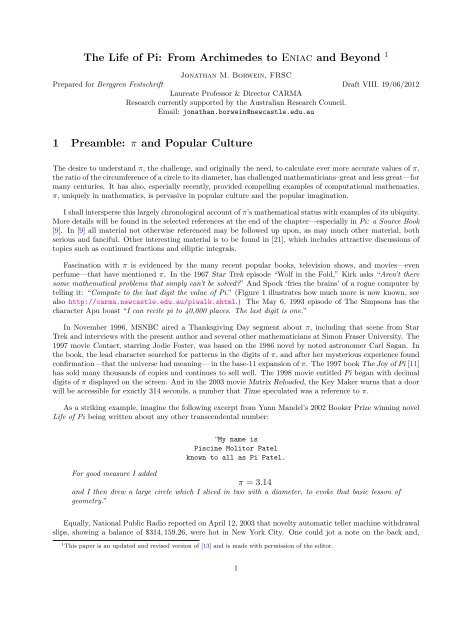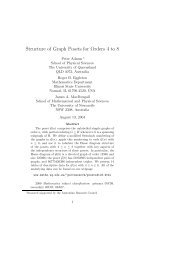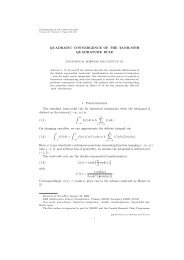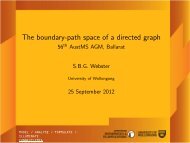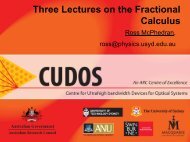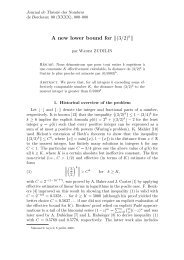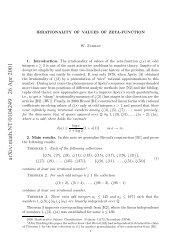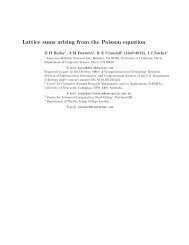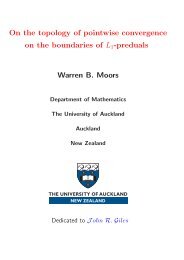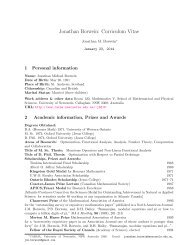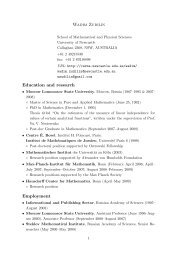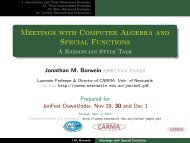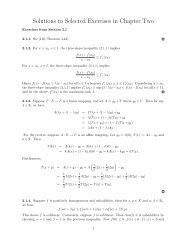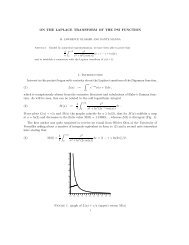The Life of Pi: From Archimedes to Eniac and Beyond 1 1 ... - CARMA
The Life of Pi: From Archimedes to Eniac and Beyond 1 1 ... - CARMA
The Life of Pi: From Archimedes to Eniac and Beyond 1 1 ... - CARMA
Create successful ePaper yourself
Turn your PDF publications into a flip-book with our unique Google optimized e-Paper software.
Figure 5: <strong>Archimedes</strong>’ method <strong>of</strong> computing π with 6- <strong>and</strong> 12-gonsLittle progress was made in Europe during the ‘dark ages’, but a significant advance arose in India (450 CE):modern positional, zero-based decimal arithmetic—the “Indo-Arabic” system. This greatly enhanced arithmeticin general, <strong>and</strong> computing π in particular. <strong>The</strong> Indo-Arabic system arrived with the Moors in Europe around1000 CE. Resistance ranged from accountants who feared losing their livelihood <strong>to</strong> clerics who saw the systemas ‘diabolical’—they incorrectly assumed its origin was Islamic. European commerce resisted in<strong>to</strong> the 18thcentury, <strong>and</strong> even in scientific circles usage was limited until the 17th century. This is, <strong>of</strong> course a greatlysimplified version <strong>of</strong> extraordinary events, for a recent article on the matter see [6].<strong>The</strong> prior difficulty <strong>of</strong> doing arithmetic is indicated by college placement advice given a wealthy Germanmerchant in the 16th century:“A wealthy (15th Century) German merchant, seeking <strong>to</strong> provide his son with a good business education,consulted a learned man as <strong>to</strong> which European institution <strong>of</strong>fered the best training. ‘If youonly want him <strong>to</strong> be able <strong>to</strong> cope with addition <strong>and</strong> subtraction,’ the expert replied, ’then any Frenchor German university will do. But if you are intent on your son going on <strong>to</strong> multiplication <strong>and</strong>division—assuming that he has sufficient gifts—then you will have <strong>to</strong> send him <strong>to</strong> Italy.’” (GeorgeIfrah, [14])Discussions about Roman arithmetic continue. Claude Shannon (1916–2001) had a mechanical calcula<strong>to</strong>rwryly called Throback 1 built <strong>to</strong> compute in Roman, at Bell Labs in 1953 <strong>to</strong> show that it was practicable, if atad messy, <strong>to</strong> compute using Roman numerals!Ludolph van Ceulen (1540–1610). <strong>The</strong> last great Archimedean calculation, performed by van Ceulen using2 62 -gons—<strong>to</strong> 39 places with 35 correct—was published posthumously. <strong>The</strong> number is still called Ludolph’snumber in parts <strong>of</strong> Europe <strong>and</strong> was inscribed on his head-s<strong>to</strong>ne. This head-s<strong>to</strong>ne disappeared centuries ago butwas rebuilt, in part from surviving descriptions, recently as shown in Figure 7. It was reconsecrated on July5th 2000 with Dutch royalty in attendance. Ludolph van Ceulen, a very serious mathematician, was also thediscoverer <strong>of</strong> the double angle formula for the cosine.6
Name Year DigitsBabylonians 2000? BCE 1Egyptians 2000? BCE 1Hebrews (1 Kings 7:23) 550? BCE 1<strong>Archimedes</strong> 250? BCE 3P<strong>to</strong>lemy 150 3Liu Hui 263 5Tsu Ch’ung Chi 480? 7Al-Kashi 1429 14Romanus 1593 15van Ceulen (Ludolph’s number ∗ ) 1615 354 <strong>Pi</strong>’s AdolescenceFigure 6: Pre-calculus π CalculationsFrançois Viéte (1540–1603). <strong>The</strong> dawn <strong>of</strong> modern mathematics appears in Viéte’s or Viéta’s product (1579)√ √ √2 2 2 + 2π = 2 2√2 + √ 2 + √ 2considered <strong>to</strong> be the first truly infinite product; <strong>and</strong> in the first infinite continued fraction for 2/π given by LordBrouncker (1620–1684), first President <strong>of</strong> the Royal Society <strong>of</strong> London:2π = 191 +252 +2 + 492 + · · ·This was based on the following brilliantly ‘interpolated’ product <strong>of</strong> John Wallis 2 (1616–1703):2.· · ·(3)∞∏k=14k 2 − 14k 2 = 2 π ,which led <strong>to</strong> the discovery <strong>of</strong> the Gamma function (see End Note 2) <strong>and</strong> a great deal more. Variations on theseformulas <strong>of</strong> Víete <strong>and</strong> Wallis continue <strong>to</strong> be published.A flavour <strong>of</strong> Viéte’s writings can be gleaned in this quotation from his work, first given in English in [9, p.759]. What we now take for granted was reason for much passionate argument.“Arithmetic is absolutely as much science as geometry [is]. Rational magnitudes are convenientlydesignated by rational numbers, <strong>and</strong> irrational [magnitudes] by irrational [numbers]. If someonemeasures magnitudes with numbers <strong>and</strong> by his calculation get them different from what they reallyare, it is not the reckoning’s fault but the reckoner’s.Rather, says Proclus, arithmetic is more exact than geometry. 3 To an accurate calcula<strong>to</strong>r,if the diameter is set <strong>to</strong> one unit, the circumference <strong>of</strong> the inscribed dodecagon will be the side <strong>of</strong> thebinomial [i.e. square root <strong>of</strong> the difference] 72 − √ 3888. Whosoever declares any other result, will bemistaken, either the geometer in his measurements or the calcula<strong>to</strong>r in his numbers.” (Viéte)2 One <strong>of</strong> the few mathematicians whom New<strong>to</strong>n admitted respecting, <strong>and</strong> also a calculating prodigy!3 <strong>The</strong> capitalized phrase was written in Greek.7
Figure 7: Ludolph’s rebuilt <strong>to</strong>mbs<strong>to</strong>ne in LeidenThis fluent rendition is due <strong>to</strong> Marinus Taisbak, <strong>and</strong> the full text is worth reading. It certainly underlines howinfluential an algebraist <strong>and</strong> geometer Viéte was—as an early proponent <strong>of</strong> methods we now take for granted.Viéte, who was the first <strong>to</strong> introduce literals (‘x’ <strong>and</strong> ‘y’) in<strong>to</strong> algebra, nonetheless rejected the use <strong>of</strong> negativenumbers.Leonard Euler (1707–1783). Not surprisingly the great Euler ‘master <strong>of</strong> us all’ [20] made many contributions<strong>to</strong> the literature on π. Equation (3) may be derived from Euler’s product formula for π, given below in(4), with x = 1/2, or by repeatedly integrating ∫ π/2sin 2n (t) dt by parts. One may divine (4) as Euler did0by considering sin(πx) as an ‘infinite’ polynomial <strong>and</strong> obtaining a product in terms <strong>of</strong> the roots—which are0, {1/n 2 : n = ±1, ±2, · · · }. It is thus plausible that(4)sin(π x)x= c∞∏) (1 − x2n 2 .Euler in 1735, full well knowing that the whole argument was heuristic, argued that, as with a polynomial,c was the value at zero, 1, <strong>and</strong> the coefficient <strong>of</strong> x 2 in the Taylor series must be the sum <strong>of</strong> the roots. Hence, hewas able <strong>to</strong> pick <strong>of</strong>f coefficients <strong>to</strong> evaluate the zeta-function at two:ζ(m) := ∑ n≥1n=11π2<strong>and</strong> marvellously ζ(2) =nm 6 .<strong>The</strong> explicit formula for ζ(2) solved the so called Basel problem posed in 1644. This method also leads <strong>to</strong> theevaluation <strong>of</strong> ζ(2n) as a rational multiple <strong>of</strong> π 2n :Indeed, it produces:ζ(2) = π26π4 π6 π8, ζ(4) = , ζ(6) = , ζ(8) =90 945 9450 , . . .m−1 (2π)2mζ(2m) = (−1)2 (2m)! B 2m,in terms <strong>of</strong> the Bernoulli numbers, B n , where t/(exp(t) − 1) = ∑ n≥0 B nt n /n!, gives a generating function forthe B n which are perforce rational; see also [28].8
in 54 seconds; two 20-digit numbers in six minutes; two 40-digit numbers in 40 minutes; two 100-digit numbersin 8 hours <strong>and</strong> 45 minutes. In 1844, after being shown( ) ( ) ( )π1 1 14 = tan−1 + tan −1 + tan −1258he calculated π <strong>to</strong> 200 places in his head in two months, completing correctly—<strong>to</strong> my mind—the greatestmental computation ever. Dase later calculated a seven-digit logarithm table, <strong>and</strong> extended a table <strong>of</strong> integerfac<strong>to</strong>rizations <strong>to</strong> 10,000,000. On Gauss’s recommendation Dase was hired <strong>to</strong> assist this project, but Dase diednot long afterwards in 1861 by which time Gauss himself already was dead.An amusing Machin-type identity—meaning an equation that expresses π as a linear combination <strong>of</strong>arctan’s—due <strong>to</strong> the Oxford logician Charles Dodgson is( ) ( ) ( )1 11tan −1 = tan −1 + tan −1 ,pp + qp + rvalid whenever 1 + p 2 fac<strong>to</strong>rs as qr. Dodgson is much better known as Lewis Carroll, the author <strong>of</strong> Alice inWonderl<strong>and</strong>.7 <strong>The</strong> Irrationality <strong>and</strong> Transcendence <strong>of</strong> πOne motivation for computations <strong>of</strong> π was very much in the spirit <strong>of</strong> modern experimental mathematics: <strong>to</strong>see if the decimal expansion <strong>of</strong> π repeats, which would mean that π is the ratio <strong>of</strong> two integers (i.e., rational),or <strong>to</strong> recognize π as algebraic—the root <strong>of</strong> a polynomial with integer coefficients—<strong>and</strong> later <strong>to</strong> look at digitdistribution. <strong>The</strong> question <strong>of</strong> the rationality <strong>of</strong> π was settled in the late 1700s, when Lambert <strong>and</strong> Legendreproved (using continued fractions) that the constant is irrational.<strong>The</strong> question <strong>of</strong> whether π was algebraic was settled in 1882, when Lindemann proved that π is transcendental.Lindemann’s pro<strong>of</strong> also settled, once <strong>and</strong> for all, the ancient Greek question <strong>of</strong> whether the circle could besquared with straight-edge <strong>and</strong> compass. It cannot be, because numbers that are the lengths <strong>of</strong> lines that can beconstructed using ruler <strong>and</strong> compasses (<strong>of</strong>ten called constructible numbers) are necessarily algebraic, <strong>and</strong> squaringthe circle is equivalent <strong>to</strong> constructing the value π. <strong>The</strong> classical Athenian playwright Aris<strong>to</strong>phanes already‘knew’ this <strong>and</strong> perhaps derided ‘circle-squarers’ (τετραγωσιειν) in his play <strong>The</strong> Birds <strong>of</strong> 414 BCE. Likewise,the French Academy had s<strong>to</strong>pped accepting pro<strong>of</strong>s <strong>of</strong> the three great constructions <strong>of</strong> antiquity—squaring thecircle, doubling the cube <strong>and</strong> trisecting the angle—centuries before it was proven impossible.We next give, in extenso, Ivan Niven’s 1947 short pro<strong>of</strong> <strong>of</strong> the irrationality <strong>of</strong> π. It well illustrates theingredients <strong>of</strong> more difficult later pro<strong>of</strong>s <strong>of</strong> irrationality <strong>of</strong> other constants, <strong>and</strong> indeed <strong>of</strong> Lindemann’s pro<strong>of</strong> <strong>of</strong>the transcendence <strong>of</strong> π building on Hermite’s 1873 pro<strong>of</strong> <strong>of</strong> the transcendence <strong>of</strong> e.8 A Pro<strong>of</strong> that π is IrrationalPro<strong>of</strong>. Let π = a/b, the quotient <strong>of</strong> positive integers. We define the polynomialsf(x) = xn (a − bx) nn!F (x) = f(x) − f (2) (x) + f (4) (x) − · · · + (−1) n f (2n) (x)the positive integer being specified later. Since n!f(x) has integral coefficients <strong>and</strong> terms in x <strong>of</strong> degree notless than n, f(x) <strong>and</strong> its derivatives f (j) (x) have integral values for x = 0; also for x = π = a/b, since12
f(x) = f(a/b − x). By elementary calculus we have<strong>and</strong>ddx {F ′ (x) sin x − F (x) cos x} = F ′′ (x) sin x + F (x) sin x = f(x) sin x∫ π0f(x) sin x dx = [F ′ (x) sin x − F (x) cos x] π 0(12)= F (π) + F (0).Now F (π) + F (0) is an integer, since f (j) (0) <strong>and</strong> f (j) (π) are integers. But for 0 < x < π,0 < f(x) sin x < πn a n,n!so that the integral in (12) is positive but arbitrarily small for n sufficiently large. Thus (12) is false, <strong>and</strong> so isour assumption that π is rational.QEDIrrationality measures. We end this section by <strong>to</strong>uching on the matter <strong>of</strong> measures <strong>of</strong> irrationality. <strong>The</strong>infimum µ(α) <strong>of</strong> those µ > 0 for which∣ α − p q ∣ ≥ 1q µfor all integers p, q with sufficiently large q, is called the Liouville-Roth constant for α <strong>and</strong> we say that we havean irrationality measure for α if µ(α) < ∞.Irrationality measures are difficult. Roth’s theorem, [15], implies that µ(α) = 2 for all algebraic irrationals,as is the case for almost all reals. Clearly, µ(α) = 1 for rational α <strong>and</strong> µ(α) = ∞ if <strong>and</strong> only if α is a so-calledLiouville number such as ∑ 1/10 n! . It is known that µ(e) = 2 while in 1993 Hata showed that µ(π) ≤ 8.02.Similarly, it is known that µ(ζ(2)) ≤ 5.45, µ(ζ(3)) ≤ 4.8 <strong>and</strong> µ(log 2) ≤ 3.9.A consequence <strong>of</strong> the existence <strong>of</strong> an irrationality measure µ for π, is the ability <strong>to</strong> estimate quantities suchas lim sup | sin(n)| 1/n = 1 for integer n, since for large integer m <strong>and</strong> n with m/n → π, we have eventually| sin(n)| = | sin(mπ) − sin(n)| ≥ 1 2 |mπ − n| ≥ 12 m µ−1 .Related matters are discussed at more length in [2].9 π in the Digital AgeWith the substantial development <strong>of</strong> computer technology in the 1950s, π was computed <strong>to</strong> thous<strong>and</strong>s <strong>and</strong>then millions <strong>of</strong> digits. <strong>The</strong>se computations were greatly facilitated by the discovery soon after <strong>of</strong> advancedalgorithms for the underlying high-precision arithmetic operations. For example, in 1965 it was found that thenewly-discovered fast Fourier transform (FFT) [15, 14] could be used <strong>to</strong> perform high-precision multiplicationsmuch more rapidly than conventional schemes. Such methods (e.g., for ÷, √ x see [15, 16, 14]) dramaticallylowered the time required for computing π <strong>and</strong> other constants <strong>to</strong> high precision. We are now able <strong>to</strong> computealgebraic values <strong>of</strong> algebraic functions essentially as fast as we can multiply, O B (M(N)), where M(N) is thecost <strong>of</strong> multiplication <strong>and</strong> O B counts ‘bits’ or ‘flops’. To convert this in<strong>to</strong> practice: a state-<strong>of</strong>-the-art processorin 2010, such as the latest AMD Opteron, which runs at 2.4 GHz <strong>and</strong> has four floating-point cores, each <strong>of</strong>13
which can do two 64-bit floating-point operations per second, can produce a <strong>to</strong>tal <strong>of</strong> 9.6 billion floating-poin<strong>to</strong>perations per second.In spite <strong>of</strong> these advances, in<strong>to</strong> the 1970s all computer evaluations <strong>of</strong> π still employed classical formulae,usually <strong>of</strong> Machin-type, see Figure 8. We will see below methods that can compute N digits <strong>of</strong> π with timecomplexity O B (M(N)) log O B (M(N)). Proving that the log term is unavoidable, as seems likely, would yieldan algorithmic pro<strong>of</strong>—quite different from current pro<strong>of</strong>s—that π is not algebraic. Such a pro<strong>of</strong> would be asignificant contribution <strong>to</strong> number theory <strong>and</strong> complexity theory.Electronic Numerical Integra<strong>to</strong>r <strong>and</strong> Calcula<strong>to</strong>r. <strong>The</strong> first computer calculation <strong>of</strong> π was performedon ENIAC—a behemoth with a tiny brain from <strong>to</strong>day’s vantage point. <strong>The</strong> ENIAC was built in Aberdeen,Maryl<strong>and</strong> by the US Army:Size/weight. ENIAC had 18,000 vacuum tubes, 6,000 switches, 10,000 capaci<strong>to</strong>rs, 70,000 resis<strong>to</strong>rs,1,500 relays, was 10 feet tall, occupied 1,800 square feet <strong>and</strong> weighed 30 <strong>to</strong>ns.Speed/memory. A, now aged, 1.5GHz Pentium does 3 million adds/sec. ENIAC did 5,000, threeorders faster than earlier machines. <strong>The</strong> first s<strong>to</strong>red-memory computer, ENIAC s<strong>to</strong>red 200 digits.Input/output. Data flowed from one accumula<strong>to</strong>r <strong>to</strong> the next, <strong>and</strong> after each accumula<strong>to</strong>r finisheda calculation, it communicated its results <strong>to</strong> the next in line. <strong>The</strong> accumula<strong>to</strong>rs were connected <strong>to</strong>each other manually. <strong>The</strong> 1949 computation <strong>of</strong> π <strong>to</strong> 2,037 places on ENIAC <strong>to</strong>ok 70 hours in whichoutput had <strong>to</strong> be constantly reintroduced as input.A fascinating description <strong>of</strong> the ENIAC’s technological <strong>and</strong> commercial travails is <strong>to</strong> be found in [25]. Note thatENIAC as a child <strong>of</strong> the 1940’s was called a ‘calcula<strong>to</strong>r’ not a computer.Ballantine’s (1939) Series for π. Another formula <strong>of</strong> Euler for arccot is∞∑ (n!) 2 4 n( ) 1x(2 n + 1)! (x 2 + 1) n+1 = arctan .xn=0This, intriguingly <strong>and</strong> usefully, allowed Guilloud <strong>and</strong> Boyer <strong>to</strong> reexpress the formula, used by them in 1973 <strong>to</strong>compute a million digits <strong>of</strong> π, viz, π/4 = 12 arctan (1/18) + 8 arctan (1/57) − 5 arctan (1/239) in the efficientformπ = 864∞∑n=0(n!) 2 4 n∞(2 n + 1)! 325 n+1 + 1824 ∑where the terms <strong>of</strong> the second series are now just decimal shifts <strong>of</strong> the first.n=0(n!) 2 4 n( ) 1(2 n + 1)! 3250 n+1 − 20 arctan ,239Ramanujan-type elliptic series. Truly new types <strong>of</strong> infinite series formulae, based on elliptic integralapproximations, were discovered around 1910 by Srinivasa Ramanujan (1887–1920) (shown in Figure 10) butwere not well known (nor fully proven) until quite recently when his writings were fully decoded <strong>and</strong> widelypublished. <strong>The</strong>y are based on elliptic functions <strong>and</strong> are described at length in [9, 15, 14].(13)G.N. Watson (see [14]) elegantly describes his feelings on viewing formulae <strong>of</strong> Ramanujan, such as (13) below:“... a thrill which is indistinguishable from the thrill which I feel when I enter the SagrestiaNuova <strong>of</strong> the Cappella Medici <strong>and</strong> see before me the austere beauty <strong>of</strong> the four statuesrepresenting ‘Day’, ‘Night’, ‘Evening’, <strong>and</strong> ‘Dawn’ which Michelangelo has set over the<strong>to</strong>mb <strong>of</strong> Giuliano de’Medici <strong>and</strong> Lorenzo de’Medici”One <strong>of</strong> these series is the remarkable:1π= 2√ 29801∞∑k=0(4k)! (1103 + 26390k)(k!) 4 396 4k .14
Figure 10: Ramanujan’s seventy-fifth birthday stamp (courtesy Naomi Borwein-YaoEach term <strong>of</strong> this series produces an additional eight correct digits in the result. When Gosper used this formula<strong>to</strong> compute 17 million digits <strong>of</strong> π in 1985, <strong>and</strong> it agreed <strong>to</strong> many millions <strong>of</strong> places with the prior estimates,this concluded the first pro<strong>of</strong> <strong>of</strong> (13). As described in [17], this computation can be shown <strong>to</strong> be exact enough<strong>to</strong> constitute a bona fide pro<strong>of</strong> ! Actually, Gosper first computed the simple continued fraction for π, hoping<strong>to</strong> discover some new things in its expansion, but found none. At the time <strong>of</strong> writing 500 million terms <strong>of</strong> thecontinued fraction for π have been computed by Neil Bickford (a teenager) without shedding light on whetherthe sequence is unbounded (see [1]).At about the same time, David <strong>and</strong> Gregory Chudnovsky found the following rational variation <strong>of</strong> Ramanujan’sformula. Amazingly one can show that it exists because √ −163 corresponds <strong>to</strong> an imaginary quadraticfield with class number one:(14)1π= 12∞∑k=0(−1) k (6k)! (13591409 + 545140134k)(3k)! (k!) 3 640320 3k+3/2Each term <strong>of</strong> this series produces an additional 14 correct digits. <strong>The</strong> Chudnovskys, shown in Figure 14,implemented this formula using a clever scheme that enabled them <strong>to</strong> use the results <strong>of</strong> an initial level <strong>of</strong>precision <strong>to</strong> extend the calculation <strong>to</strong> even higher precision. <strong>The</strong>y used this in several large calculations <strong>of</strong> π,culminating with a then record computation <strong>of</strong> over four billion decimal digits in 1994. <strong>The</strong>ir remarkables<strong>to</strong>ry was <strong>to</strong>ld compellingly by Richard Pres<strong>to</strong>n in a prizewinning New Yorker article “<strong>The</strong> Mountains <strong>of</strong> <strong>Pi</strong>”(March 2, 1992).While the Ramanujan <strong>and</strong> Chudnovsky series are in practice considerably more efficient than classical formulae,they share the property that the number <strong>of</strong> terms needed increases linearly with the number <strong>of</strong> digitsdesired: if you want <strong>to</strong> compute twice as many digits <strong>of</strong> π, you must evaluate twice as many terms <strong>of</strong> the series.(15)Relatedly, the Ramanujan-type series1π=(( ∞∑ 2n)) 3n 42 n + 516 n 16n=0allows one <strong>to</strong> compute the billionth binary digit <strong>of</strong> 1/π, or the like, without computing the first half <strong>of</strong> the series,<strong>and</strong> is a foretaste <strong>of</strong> our later discussion <strong>of</strong> Borwein-Bailey-Plouffe (or BBP) formulae.15
Name Year Correct DigitsMiyoshi <strong>and</strong> Kanada 1981 2,000,036Kanada-Yoshino-Tamura 1982 16,777,206Gosper 1985 17,526,200Bailey Jan. 1986 29,360,111Kanada <strong>and</strong> Tamura Sep. 1986 33,554,414Kanada <strong>and</strong> Tamura Oct. 1986 67,108,839Kanada et. al Jan. 1987 134,217,700Kanada <strong>and</strong> Tamura Jan. 1988 201,326,551Chudnovskys May 1989 480,000,000Kanada <strong>and</strong> Tamura Jul. 1989 536,870,898Kanada <strong>and</strong> Tamura Nov. 1989 1,073,741,799Chudnovskys Aug. 1991 2,260,000,000Chudnovskys May 1994 4,044,000,000Kanada <strong>and</strong> Takahashi Oct. 1995 6,442,450,938Kanada <strong>and</strong> Takahashi Jul. 1997 51,539,600,000Kanada <strong>and</strong> Takahashi Sep. 1999 206,158,430,000Kanada-Ushiro-Kuroda Dec. 2002 1,241,100,000,000Takahashi Jan. 2009 1,649,000,000,000Takahashi April. 2009 2,576,980,377,524Bellard Dec. 2009 2,699,999,990,000Figure 11: Post-calculus π Calculations10 Reduced Operational Complexity AlgorithmsIn 1976, Eugene Salamin <strong>and</strong> Richard Brent independently discovered a reduced complexity algorithm for π. It isbased on the arithmetic-geometric mean iteration (AGM) <strong>and</strong> some other ideas due <strong>to</strong> Gauss <strong>and</strong> Legendrearound 1800, although neither Gauss, nor many after him, ever directly saw the connection <strong>to</strong> effectivelycomputing π.Quadratic Algorithm (Salamin-Brent).Set a 0 = 1, b 0 = 1/ √ 2 <strong>and</strong> s 0 = 1/2. Calculate(16)(17)a k = a k−1 + b k−12(Arithmetic) b k = √ a k−1 b k−1 (Geometric)c k = a 2 k − b 2 k, s k = s k−1 − 2 k c k <strong>and</strong> compute p k = 2a2 ks k.<strong>The</strong>n p k converges quadratically <strong>to</strong> π. Note the similarity between the arithmetic-geometric mean iteration (16),(which for general initial values converges quickly <strong>to</strong> a non-elementary limit) <strong>and</strong> the out-<strong>of</strong>-kilter harmonicgeometricmean iteration (2) (which in general converges slowly <strong>to</strong> an elementary limit), <strong>and</strong> which is anarithmetic-geometric iteration in the reciprocals (see [15]).Each iteration <strong>of</strong> the algorithm doubles the correct digits. Successive iterations produce 1, 4, 9, 20, 42, 85, 173, 347<strong>and</strong> 697 good decimal digits <strong>of</strong> π, <strong>and</strong> takes log N operations for N digits. Twenty-five iterations computes π<strong>to</strong> over 45 million decimal digit accuracy. A disadvantage is that each <strong>of</strong> these iterations must be performed <strong>to</strong>the precision <strong>of</strong> the final result. In 1985, my brother Peter <strong>and</strong> I discovered families <strong>of</strong> algorithms <strong>of</strong> this type.For example, here is a genuinely third-order iteration 6 :6 A fourth-order iteration might be a compound <strong>of</strong> two second-order ones; this third order one can not be so decomposed.16
Cubic Algorithm.Set a 0 = 1/3 <strong>and</strong> s 0 = ( √ 3 − 1)/2. Iterater k+1 =31 + 2(1 − s 3 , s k )1/3 k+1 = r k+1 − 12<strong>and</strong> a k+1 = r 2 k+1a k − 3 k (r 2 k+1 − 1).<strong>The</strong>n 1/a k converges cubically <strong>to</strong> π. Each iteration triples the number <strong>of</strong> correct digits.Quartic Algorithm.Set a 0 = 6 − 4 √ 2 <strong>and</strong> y 0 = √ 2 − 1. Iteratey k+1 = 1 − (1 − y4 k )1/41 + (1 − y 4 k )1/4 <strong>and</strong> a k+1 = a k (1 + y k+1 ) 4 − 2 2k+3 y k+1 (1 + y k+1 + y 2 k+1).<strong>The</strong>n 1/a k converges quartically <strong>to</strong> π. Note that only the power <strong>of</strong> 2 or 3 used in a k depends on k.Let us take an interlude <strong>and</strong> discuss:‘<strong>Pi</strong>ems’ or pi-mnemonics. <strong>Pi</strong>ems are mnemonics in which the length <strong>of</strong> each word is the corresponding digit<strong>of</strong> π. Punctuation is ignored. A better piem is both longer <strong>and</strong> better poetry.Mnemonics for π“Now I, even I, would celebrateIn rhyme inapt, the greatImmortal Syracusan, rivaled nevermore,Who in his wondrous lore,Passed on beforeLeft men for guidanceHow <strong>to</strong> circles mensurate.” (30)“How I want a drink, alcoholic <strong>of</strong> course, after the heavy lectures involvingquantum mechanics.” (15)“See I have a rhyme assisting my feeble brain its tasks <strong>of</strong>ttimes resisting.” (13)<strong>The</strong>re are many more <strong>and</strong> much longer mnemonics than the famous examples given in the inset box—see[9, p. 405, p.560, p. 659] for a fine selection. Indeed, there is whole cottage industry around the matter,http://www.huffing<strong>to</strong>npost.com/jonathan-m-borwein/pi-day_b_1341569.html?ref=science.Philosophy <strong>of</strong> mathematics. In 1997 the first occurrence <strong>of</strong> the sequence 0123456789 was found (later thanexpected heuristically) in the decimal expansion <strong>of</strong> π starting at the 17, 387, 594, 880-th digit after the decimalpoint. In consequence the status <strong>of</strong> several famous intuitionistic examples due <strong>to</strong> Brouwer <strong>and</strong> Heyting haschanged. <strong>The</strong>se challenge the principle <strong>of</strong> the excluded middle—either a predicate holds or it does not— <strong>and</strong>involve classically well-defined objects that for an intuitionist are ill-founded until one can determine when orif the sequence occurred (see [12]).For example, consider the sequence which is ‘0’ except for a ‘1’ in the first place where 0123456789 firstbegins <strong>to</strong> appear in order if it ever occurs. Did it converge when first used by Brouwer as an example? Doesit now? Was it then <strong>and</strong> is it now well defined? Classically it always was <strong>and</strong> converged <strong>to</strong> ‘0’. But, until thecomputation was done any argument about its convergence relied on the principle <strong>of</strong> the excluded middle whichintuitionists reject. Intuitionistically, it converges now. Of course, if we redefine the sequence <strong>to</strong> have its ‘1’ inthe first place that 0123456789101112 first begins, then we are still completely in the dark. But is a sign <strong>of</strong> howfar computation <strong>of</strong> π has come recently that this was never thought necessary.17
11 Back <strong>to</strong> the FutureFigure 12: Yasumasa Kanada in his Tokyo <strong>of</strong>ficeIn December 2002, Kanada computed π <strong>to</strong> over 1.24 trillion decimal digits. His team first computed π inhexadecimal (base 16) <strong>to</strong> 1,030,700,000,000 places, using the following two arctangent relations:π = 48 tan −1 1 49 + 128 tan−1 1 57 − 20 tan−1 1239 + 48 tan−1 1110443π = 176 tan −1 157 + 28 tan−1 1239 − 48 tan−1 1682 + 96 tan−1 112943 .<strong>The</strong> first formula was found in 1982 by K. Takano, a high school teacher <strong>and</strong> song writer. <strong>The</strong> second formulawas found by F. C. W. Störmer in 1896. Kanada verified the results <strong>of</strong> these two computations agreed, <strong>and</strong>then converted the hex digit sequence <strong>to</strong> decimal. <strong>The</strong> resulting decimal expansion was checked by convertingit back <strong>to</strong> hex. <strong>The</strong>se conversions are themselves non-trivial, requiring massive computation.This process is quite different from those <strong>of</strong> the previous quarter century. One reason is that reducedoperational complexity algorithms require full-scale multiply, divide <strong>and</strong> square root operations. <strong>The</strong>se in turnrequire large-scale fast Fourier transform (FFT) operations, which dem<strong>and</strong> huge amounts <strong>of</strong> memory, <strong>and</strong>massive all-<strong>to</strong>-all communication between nodes <strong>of</strong> a large parallel system. For this latest computation, eventhe very large system available in Tokyo did not have sufficient memory <strong>and</strong> network b<strong>and</strong>width <strong>to</strong> performthese operations at reasonable efficiency levels—at least not for trillion-digit computations. Utilizing arctansagain meant using many more arithmetic operations, but no system-scale FFTs, <strong>and</strong> so the method can beimplemented using ×, ÷ by smallish integer values—additionally, hex is somewhat more efficient!Kanada <strong>and</strong> his team evaluated these two formulae using a scheme analogous <strong>to</strong> that employed by Gosper<strong>and</strong> by the Chudnovskys in their series computations, in that they were able <strong>to</strong> avoid explicitly s<strong>to</strong>ring themultiprecision numbers involved. This resulted in a scheme that is roughly competitive in numerical efficiencywith the Salamin-Brent <strong>and</strong> Borwein quartic algorithms they had previously used, but with a significantly lower<strong>to</strong>tal memory requirement. Kanada used a 1 Tbyte main memory system, as with the previous computation,yet got six times as many digits. Hex <strong>and</strong> decimal evaluations included, it ran 600 hours on a 64-node Hitachi,with the main segment <strong>of</strong> the program running at a sustained rate <strong>of</strong> nearly 1 Tflop/sec.18
Hex DigitOccurrencesDecimal DigitOccurrences0 999994851341 999999456642 1000004800573 999997878054 1000003578575 999996710086 999998075037 999998187238 1000007914699 99999854780Total 10000000000000 624998811081 625002122062 624999247803 625001888444 624998073685 625000072056 624999254267 624998787948 625002167529 62500120671A 62500266095B 62499955595C 62500188610D 62499613666E 62499875079F 62499937801Total 100000000000012 Why π?Figure 13: Seemingly r<strong>and</strong>om behaviour <strong>of</strong> single digits <strong>of</strong> π in base 10 <strong>and</strong> 16What possible motivation lies behind modern computations <strong>of</strong> π, given that questions such as the irrationality<strong>and</strong> transcendence <strong>of</strong> π were settled more than 100 years ago? One motivation is the raw challenge <strong>of</strong> harnessingthe stupendous power <strong>of</strong> modern computer systems. Programming such calculations are definitely not trivial,especially on large, distributed memory computer systems.<strong>The</strong>re have been substantial practical spin-<strong>of</strong>fs. For example, some new techniques for performing the fastFourier transform (FFT), heavily used in modern science <strong>and</strong> engineering computing, had their roots in attempts<strong>to</strong> accelerate computations <strong>of</strong> π. And always the computations help in road-testing computers—<strong>of</strong>ten uncoveringsubtle hardware <strong>and</strong> s<strong>of</strong>tware errors.<strong>Beyond</strong> practical considerations lies the abiding interest in the fundamental question <strong>of</strong> the normality (digitr<strong>and</strong>omness) <strong>of</strong> π. Kanada, for example, has performed detailed statistical analysis <strong>of</strong> his results <strong>to</strong> see if thereare any statistical abnormalities that suggest π is not normal, so far the answer is “no” (see Figures 1 <strong>and</strong>13). (Kanada reports that the 10 decimal digits ending in position one trillion are 6680122702, while the 10hexadecimal digits ending in position one trillion are 3F89341CD5.) Indeed, the first computer computation <strong>of</strong> π<strong>and</strong> e on ENIAC, discussed above, was so motivated by John von Neumann. <strong>The</strong> digits <strong>of</strong> π have been studiedmore than any other single constant, in part because <strong>of</strong> the widespread fascination with <strong>and</strong> recognition <strong>of</strong> π.Very recent work, suggesting π may well be normal, can be found in <strong>and</strong> traced from [1].Changing world views. In retrospect, we may wonder why in antiquity π was not measured <strong>to</strong> an accuracyin excess <strong>of</strong> 22/7? Perhaps it reflects not an inability <strong>to</strong> do so but a very different mindset <strong>to</strong> a modern moreexperimental one. One can certainly find Roman ampitheatres where more accurate measurement than 22/7would have been helpful. Bailey <strong>and</strong> I discuss this issue in more detail in [6].In the same vein, one reason that Gauss <strong>and</strong> Ramanujan did not further develop the ideas in their identitiesfor π is that an iterative algorithm, as opposed <strong>to</strong> explicit results, was not as satisfac<strong>to</strong>ry for them (especially19
Figure 14: <strong>The</strong> remarkable Chudnovsky brothers π (courtesy D. <strong>and</strong> G. Chudnovsky)Ramanujan). Ramanujan much preferred formulae likeπ ≈ 3 √67log (5280) ,3√163log (640320) ≈ πcorrect <strong>to</strong> 9 <strong>and</strong> 15 decimal places; both <strong>of</strong> which rely on deep number theory. Contrastingly, Ramanujan in hisfamous 1914 paper Modular Equations <strong>and</strong> Approximations <strong>to</strong> <strong>Pi</strong> [9, p.253] found) 1/4 (9 2 + 192 = 3.14159265258 · · ·22“empirically, <strong>and</strong> it has no connection with the preceding theory.” Only the marked digit is wrong.Discovering the π Iterations. <strong>The</strong> genesis <strong>of</strong> the π algorithms <strong>and</strong> related material is an illustrative example<strong>of</strong> experimental mathematics. My brother <strong>and</strong> I in the early 1980’s had a family <strong>of</strong> quadratic algorithms forπ, [15], call them P N , <strong>of</strong> the kind we saw above. For N = 1, 2, 3, 4 we could prove they were correct butwere only conjectured for N = 5, 7. In each case the algorithm appeared <strong>to</strong> converge quadratically <strong>to</strong> π. Oncloser inspection while the provable cases were correct <strong>to</strong> 5, 000 digits, the empirical versions agreed with π <strong>to</strong>roughly 100 places only. Now in many ways <strong>to</strong> have discovered a “natural” number that agreed with π <strong>to</strong> thatlevel—<strong>and</strong> no more—would have been more interesting than the alternative. That seemed unlikely but recoding<strong>and</strong> rerunning the iterations kept producing identical results.Two decades ago even moderately high precision calculation was less accessible, <strong>and</strong> the code was being runremotely over a phone-line in a Berkeley Unix integer package. After about six weeks, it transpired that thepackage’s square root algorithm was badly flawed, but only if run with an odd precision <strong>of</strong> more than sixty digits!And for idiosyncratic reasons that had only been the case in the two unproven cases. Needless <strong>to</strong> say, tracingthe bug was a salutary <strong>and</strong> somewhat chastening experience. And it highlights why one checks computationsusing different sub-routines <strong>and</strong> methods.13 How <strong>to</strong> Compute the N-th Digits <strong>of</strong> πOne might be forgiven for thinking that essentially everything <strong>of</strong> interest with regards <strong>to</strong> π has been dealt with.This is suggested in the closing chapters <strong>of</strong> Beckmann’s 1971 book A His<strong>to</strong>ry <strong>of</strong> π. Ironically, the Salamin–Brent quadratically convergent iteration was discovered only five years later, <strong>and</strong> the higher-order convergent20
algorithms followed in the 1980s. <strong>The</strong>n in 1990, Rabinowitz <strong>and</strong> Wagon discovered a “spigot” algorithm forπ—the digits ‘drip out’ one by one. This permits successive digits <strong>of</strong> π (in any desired base) <strong>to</strong> be computedby a relatively simple recursive algorithm based on all previously generated digits.Even insiders are sometimes surprised by a new discovery. Prior <strong>to</strong> 1996, most researchers thought if youwant <strong>to</strong> determine the d-th digit <strong>of</strong> π, you had <strong>to</strong> generate the (order <strong>of</strong>) the entire first d digits. This is nottrue, at least for hex (base 16) or binary (base 2) digits <strong>of</strong> π. In 1996, Peter Borwein, Plouffe, <strong>and</strong> Bailey foundan algorithm for computing individual hex digits <strong>of</strong> π. It (1) yields a modest-length hex or binary digit stringfor π, from an arbitrary position, using no prior bits; (2) is implementable on any modern computer; (3) requiresno multiple precision s<strong>of</strong>tware; (4) requires very little memory; <strong>and</strong> (5) has a computational cost growing onlyslightly faster than the digit position. For example, the millionth hexadecimal digit (four millionth binary digit)<strong>of</strong> π could be found in four seconds on a 2005 Apple computer.This new algorithm is not fundamentally faster than the best known schemes if used for computing all digits<strong>of</strong> π up <strong>to</strong> some position, but its s<strong>to</strong>rage requirements, elegance <strong>and</strong> simplicity are <strong>of</strong> considerable interest, <strong>and</strong>it is easy <strong>to</strong> parallelize. It is based on the following at-the-time new formula for π:(18)π =∞∑i=0(1 416 i 8i + 1 − 28i + 4 − 18i + 5 − 1 )8i + 6which was discovered using integer relation methods (see [14]), with a computer search that ran over severalmonths <strong>and</strong> ultimately produced the (equivalent) relation:(1,1) ( 4π = 4 · 2F 1 1(19)∣ −1 + 2 arctan − log 5,42)54where the first term is a generalized Gaussian hypergeometric function evaluation. Maple <strong>and</strong> Mathematica canboth now prove (18). <strong>The</strong>y could not at the time <strong>of</strong> its discovery. A human pro<strong>of</strong> may be found in [14].<strong>The</strong> algorithm in action. In 1997, Fabrice Bellard at INRIA—whom we shall meet again in Section 15—computed 152 binary digits <strong>of</strong> π starting at the trillionth position. <strong>The</strong> computation <strong>to</strong>ok 12 days on 20workstations working in parallel over the Internet. Bellard’s scheme is based on the following variant <strong>of</strong> (18):π = 4∞∑k=0(−1) k4 k (2k + 1) − 1 64∞∑k=0(−1) k ( 321024 k 4k + 1 + 84k + 2 + 1 ),4k + 3which permits hex or binary digits <strong>of</strong> π <strong>to</strong> be calculated somewhat faster than (18) depending on the implementation.(Most claims <strong>of</strong> improved speed <strong>of</strong> algorithms are subject <strong>to</strong> many caveats.)In 1998 Colin Percival, then a 17-year-old student at Simon Fraser University (see Figure 15), accessed 25machines <strong>to</strong> calculate first the five trillionth hexadecimal digit <strong>of</strong> π, <strong>and</strong> then the ten trillionth hex digit. InSeptember 2000, he found the quadrillionth binary digit is 0, a computation that required 250 CPU-years, using1734 machines in 56 countries. We record some <strong>of</strong> Percival’s computational results in Figure 15.Nor have matters s<strong>to</strong>pped there. As described in [5, 8] in the most recent computation <strong>of</strong> π using theBBP formula, Tse-Wo Zse <strong>of</strong> Yahoo! Cloud Computing calculated 256 binary digits <strong>of</strong> π starting at the twoquadrillionth bit. He then checked his result using Bellard’s variant. In this case, both computations verifiedthat the 24 hex digits beginning immediately after the 500 trillionth hex digit (i.e., after the two quadrillionthbinary bit) are: E6C1294A ED40403F 56D2D764.Kanada was able <strong>to</strong> confirm his 2002 computation in only 21 hours by computing a 20 hex digit stringstarting at the trillionth digit, <strong>and</strong> comparing this string <strong>to</strong> the hex string he had initially obtained in over 600hours. <strong>The</strong>ir agreement provided enormously strong confirmation. We shall see this use <strong>of</strong> BBP for verificationagain when we discuss the most recent record computations <strong>of</strong> π.21
Colin Percival (1998)PositionHex strings startingat this Position10 6 26C65E52CB459310 7 17AF5863EFED8D10 8 ECB840E21926EC10 9 85895585A0428B10 10 921C73C6838FB210 11 9C381872D275961.25 × 10 12 07E45733CC790B2.5 × 10 14 E6216B069CB6C114 Further BBP Digit FormulaeFigure 15: Percival’s hexadecimal findingsMotivated as above, constants α <strong>of</strong> the form(20)α =∞∑k=0p(k)q(k)2 k ,where p(k) <strong>and</strong> q(k) are integer polynomials, are said <strong>to</strong> be in the class <strong>of</strong> binary (Borwein-Bailey-Plouffe) BBPnumbers. I illustrate for log 2 why this permits one <strong>to</strong> calculate isolated digits in the binary expansion:log 2 =∞∑k=01k2 k .(21)We wish <strong>to</strong> compute a few binary digits beginning at position d + 1. This is equivalent <strong>to</strong> calculating{2 d log 2}, where {·} denotes fractional part. We can write{{ d∑} {{2 d 2 d−k∞}}∑ 2 d−k(22)log 2} =+kkk=0k=d+1{{ d∑} {2 d−k mod k ∑ ∞(23)=+kkk=0k=d+1<strong>The</strong> key observation is that the numera<strong>to</strong>r <strong>of</strong> the first sum in (23), 2 d−k mod k, can be calculated rapidly bybinary exponentiation, performed modulo k. That is, it is economically performed by a fac<strong>to</strong>rization based onthe binary expansion <strong>of</strong> the exponent. For example,3 17 = ((((3 2 ) 2 ) 2 ) 2 ) · 3uses only five multiplications, not the usual 16. It is important <strong>to</strong> reduce each product modulo k. Thus, 3 17mod 10 is done as3 2 = 9; 9 2 = 1; 1 2 = 1; 1 2 = 1; 1 × 3 = 3.2 d−k}}.A natural question in light <strong>of</strong> (18) is whether there is a formula <strong>of</strong> this type <strong>and</strong> an associated computationalstrategy <strong>to</strong> compute individual decimal digits <strong>of</strong> π. Searches conducted by numerous researchers have beenunfruitful <strong>and</strong> recently D. Borwein (my father), Gallway <strong>and</strong> I have shown that there are no BBP formulae <strong>of</strong>the Machin-type (as defined in [14]) <strong>of</strong> (18) for π unless the base is a power <strong>of</strong> two [14].22
Figure 16: Ferguson’s “Eight-Fold Way” <strong>and</strong> his BBP acrylic circles. <strong>The</strong>se three ‘subtractive’ acrylic circles(white) <strong>and</strong> the black circle represent the weights [4, −2, −2, −1] in Equation (18)Ternary BBP formulae. Yet, BBP formulae exist in other bases for some constants. For example, for π 2we have both binary <strong>and</strong> ternary formulae (discovered by Broadhurst):(24)(25)π 2 = 9 8π 2 = 227∞∑()1 1664 k (6k + 1) − 242 (6k + 2) − 82 (6k + 3) − 62 (6k + 4) + 1.2 (6k + 5) 2k=0∞∑(1 243729 k (12k + 1) − 4052 (12k + 2) − 812 (12k + 4) − 272 (12k + 5) 2k=0)72−(12k + 6) − 92 (12k + 7) − 92 (12k + 8) − 52 (12k + 10) + 1.2 (12k + 11) 2<strong>The</strong>se two formulae have recently been used for record digit computations performed on an IBM Blue Genesystem in conjunction with IBM Australia [8].Remarkably the volume V 8 in hyperbolic space <strong>of</strong> the figure-eight knot complement is well known <strong>to</strong> beV 8 = 2 √ 3∞∑ 1n ( )2nnn=12n−1∑k=n1k = 2.029883212819307250042405108549 . . .Surprisingly, it is also expressible as√3∞∑ (−1) n {}18V 8 =9 27 n (6n + 1) 2 − 18(6n + 2) 2 − 24(6n + 3) 2 − 6(6n + 4) 2 + 2(6n + 5) 2 ,n=0again discovered numerically by Broadhurst, <strong>and</strong> proved in [14]. A beautiful representation by Helaman Fergusonthe mathematical sculp<strong>to</strong>r is given in Figure 16. Ferguson produces art inspired by deep mathematics, but notby a formulaic approach. For instance, his knowledge <strong>of</strong> hyperbolic geometry allows him <strong>to</strong> exploit surfaces <strong>of</strong>negative curvature as shown in his“Eight-Fold Way”.Normality <strong>and</strong> dynamics. Finally, Bailey <strong>and</strong> Cr<strong>and</strong>all in 2001 made exciting connections between theexistence <strong>of</strong> a b-ary BBP formula for α <strong>and</strong> its normality base b (uniform distribution <strong>of</strong> base-b digits) 7 . <strong>The</strong>y7 See www.sciencenews.org/20010901/bob9.asp .23
make a reasonable, hence very hard, conjecture about the uniform distribution <strong>of</strong> a related chaotic dynamicalsystem. This conjecture implies: Existence <strong>of</strong> a ‘BBP’ formula base b for α ensures the normality base b <strong>of</strong> α.Illustratively, or log 2 8 , the dynamical system, base 2, is <strong>to</strong> set x 0 = 0 <strong>and</strong> compute(x n+1 ←↪ 2 x n + 1 )mod 1.n15 <strong>Pi</strong> in the Third Millennium15.1 Reciprocal seriesA few years ago Jesús Guillera found various Ramanujan-like identities for π, using integer relation methods.<strong>The</strong> three most basic are:4∞∑( 2n+1 1(26)π 2 = (−1) n r(n) 5 (13 + 180n + 820n 2 )32)(27)(28)2π 2 =n=0∞∑( 2n+1 1(−1) n r(n) 5 (1 + 8n + 20n 2 )2)n=04 ?=∑ ∞π 3n=0where r(n) := (1/2 · 3/2 · · · · · (2n − 1)/(2n))/n!.( ) 2n+1 1r(n) 7 (1 + 14n + 76n 2 + 168n 3 ) ,8Guillera proved (26) <strong>and</strong> (27) in t<strong>and</strong>em, using most ingeniously the Wilf–Zeilberger algorithm for formallyproving hypergeometric-like identities [14, 7, 29]. No other pro<strong>of</strong> is known <strong>and</strong> there seem <strong>to</strong> be no like formulaefor 1/π d with d ≥ 4. <strong>The</strong> third (28) is certainly true, 9 but has no pro<strong>of</strong>; nor does anyone have an inkling <strong>of</strong>how <strong>to</strong> prove it; especially as experiment suggests that it has no ‘mate’ unlike (26) <strong>and</strong> (27) [7]. My intuition isthat if a pro<strong>of</strong> exists it is more a verification than an explication <strong>and</strong> so I s<strong>to</strong>pped looking. I am happy just <strong>to</strong>know the beautiful identity is true. A very nice account <strong>of</strong> the current state <strong>of</strong> knowledge for Ramanujan-typeseries for 1/π is <strong>to</strong> be found in [10].In 2008 Guillera [22] produced another lovely pair <strong>of</strong> third millennium identities—discovered with integerrelation methods <strong>and</strong> proved with creative telescoping—this time for π 2 rather than its reciprocal. <strong>The</strong>y are(29)<strong>and</strong>( ∞∑ 1 x +1 32)n2 2n (x + 1) 3 nn=0(6(n + x) + 1) = 8x∞∑n=0( 1) 22 n(x + 1) 2 ,n(30)( ∞∑ 1 x +1 32)n2 6n (x + 1) 3 nn=0(42(n + x) + 5) = 32x∞∑n=0(x +1 22)n(2x + 1) 2 .nHere (a) n = a(a + 1) · ·(a + n − 1) is the rising fac<strong>to</strong>rial. Substituting x = 1/2 in (29) <strong>and</strong> (30), he obtainedrespectively the formulae∞∑ 1 (1) 3 n2 2nn=0( 3) 32 n(3n + 2) = π24<strong>and</strong>∞∑ 1 (1) 3 n2 6n−2n=0( 3) 32 n(21n + 13) = π23 .8 In this case it is easy <strong>to</strong> use Weyl’s criterion for equidistribution <strong>to</strong> establish this equivalence without mention <strong>of</strong> BBP numbers.9 Guillera ascribes (28) <strong>to</strong> Gourevich, who used integer relation methods. I ‘rediscovered’ (28) using integer relation methods with30 digits. I then checked it <strong>to</strong> 500 places in 10 seconds, 1200 in 6.25 minutes, <strong>and</strong> 1500 in 25 minutes: with a naive comm<strong>and</strong>-lineinstruction in Maple on a light lap<strong>to</strong>p.24
15.2 Computational records<strong>The</strong> last decade has seen the record for computation <strong>of</strong> π broken in some very interesting ways. We have alreadydescribed Kanada’s 2002 computation in Section 11 <strong>and</strong> noted that he also <strong>to</strong>ok advantage <strong>of</strong> the BBP formula<strong>of</strong> Section 13. This s<strong>to</strong>od as a record until 2009 when it was broken three times—twice spectacularly.Daisuke Takahashi. <strong>The</strong> record for computation <strong>of</strong> π <strong>of</strong> under 29.37 million decimal digits, by Bailey in1986 had increased <strong>to</strong> over 2.649 trillion places by Takahashi in January 2009. Since the same algorithms wereused for each computation, it is interesting <strong>to</strong> review the performance in each case:In 1986 it <strong>to</strong>ok 28 hours <strong>to</strong> compute 29.36 million digits on 1 cpu <strong>of</strong> the then new CRAY-2 at NASA Amesusing (18). Confirmation using the quadratic algorithm (16) <strong>to</strong>ok 40 hours. (<strong>The</strong> computation uncoveredhardware <strong>and</strong> s<strong>of</strong>tware errors on the CRAY. Success required developing a speedup <strong>of</strong> the underlying FFT [14].)In comparison, on 1024 cores <strong>of</strong> a 2592 core Appro Xtreme-X3 system 2.649 trillion digits via (16) <strong>to</strong>ok 64hours 14 minutes with 6732 GB <strong>of</strong> main memory, <strong>and</strong> (18) <strong>to</strong>ok 73 hours 28 minutes with 6348 GB <strong>of</strong> mainmemory. (<strong>The</strong> two computations differed only in the last 139 places.) In April Takahashi upped his record <strong>to</strong>2,576,980,377,524 places.Fabrice Bellard. Near the end <strong>of</strong> 2009, Bellard computed nearly 2.7 trillion decimal digits <strong>of</strong> π (first inbinary) using the Chudnovsky series (14). This <strong>to</strong>ok 131 days but he only used a single 4-core workstation witha lot <strong>of</strong> s<strong>to</strong>rage <strong>and</strong> even more human intelligence! For full details <strong>of</strong> this feat <strong>and</strong> <strong>of</strong> Takahashi’s most recentcomputation one can look athttp://en.wikipedia.org/wiki/Chronology_<strong>of</strong>_computation_<strong>of</strong>_pi .Nor is that the current end <strong>of</strong> the matter:Alex<strong>and</strong>er Yee <strong>and</strong> Shigeru Kondo. In August 2010, they announced that they had used the Chudnovskyformula <strong>to</strong> compute 5 trillion digits <strong>of</strong> π over a 90-day period, mostly on a two-core Intel Xeon system with96 Gbyte <strong>of</strong> memory. <strong>The</strong>y confirmed the result in two ways, using the BBP formula (as discussed above),which required 66 hours, <strong>and</strong> a variant <strong>of</strong> the BBP formula due <strong>to</strong> Bellard, which required 64 hours. Changingfrom binary <strong>to</strong> decimal required 8 days. This was upped <strong>to</strong> 10 trillion digits in Oc<strong>to</strong>ber 2011. Full details areavailable at http://www.numberworld.org/misc_runs/pi-5t/details.html.16 . . . <strong>Life</strong> <strong>of</strong> πPaul Churchl<strong>and</strong>, writing about the sorry creationist battles <strong>of</strong> the Kansas school board, [19, Kindle ed, loc1589] observes that:“Even mathematics would not be entirely safe. (Apparently, in the early 1900’s, one legisla<strong>to</strong>r in asouthern state proposed a bill <strong>to</strong> redefine the value <strong>of</strong> pi as 3.3 exactly, just <strong>to</strong> tidy things up.)”As we have seen, the life <strong>of</strong> π captures a great deal <strong>of</strong> mathematics—algebraic, geometric <strong>and</strong> analytic, bothpure <strong>and</strong> applied—along with some his<strong>to</strong>ry <strong>and</strong> philosophy. It engages many <strong>of</strong> the greatest mathematicians<strong>and</strong> some quite interesting characters along the way. Among the saddest <strong>and</strong> least-well unders<strong>to</strong>od episodeswas an abortive 1896 attempt in Indiana <strong>to</strong> legislate the value(s) <strong>of</strong> π. <strong>The</strong> bill, reproduced in [9, p. 231-235],is is accurately described by David Singmaster, [27] <strong>and</strong> [9, p. 236-239].At the end <strong>of</strong> the novel, <strong>Pi</strong>scine (<strong>Pi</strong>) Moli<strong>to</strong>r writes25
“I am a person who believes in form, in harmony <strong>of</strong> order. Where we can, we must give things ameaningful shape. For example—I wonder—could you tell my jumbled s<strong>to</strong>ry in exactly one hundredchapters, not one more, not one less? I’ll tell you, that’s one thing I hate about my nickname, theway that number runs on forever. It’s important in life <strong>to</strong> conclude things properly. Only then canyou let go.”We may well not share the sentiment, but we should celebrate that <strong>Pi</strong> knows π <strong>to</strong> be irrational.17 End Notes1. Why π is not 22/7. Today, even the computer algebra systems Maple or Mathematica ‘know’ this since(31)0
for Re x > 0. <strong>The</strong> starting point is that(35)x Γ(x) = Γ(x + 1), Γ(1) = 1.In particular, for integer n, Γ(n + 1) = n!. Also for 0 < x < 1since for x > 0 we haveΓ(x) Γ(1 − x) =Γ(x) = limn→∞∏ nk=0πsin(πx) ,n! n x(x + k).This is a nice consequence <strong>of</strong> the Bohr-Mollerup theorem [15, 14] which shows that Γ is the unique log-convexfunction on the positive half line satisfying (35). Hence, Γ(1/2) = √ π <strong>and</strong> equivalently we evaluate the Gaussianintegral∫ ∞−∞e −x2 dx = √ π,so central <strong>to</strong> probability theory. In the same vein, the improper sinc function integral evaluates as∫ ∞−∞sin(x)xdx = π.Considerable information about the relationship between Γ <strong>and</strong> π is <strong>to</strong> be found in [14, 21].<strong>The</strong> Gamma function is as ubiqui<strong>to</strong>us as π. For example, it is shown in [18] that the expected length, W 3 , <strong>of</strong>a three-step unit-length r<strong>and</strong>om walk in the plane is given by(36) W 3 = 3 2 1/3 ( ) 116 π 4 Γ6 + 27 2 2/3 ( ) 23 4 π 4 Γ6 .3We recall that Γ(1/2) 2 = π <strong>and</strong> that similar algorithms exist for Γ(1/3), Γ(1/4), <strong>and</strong> Γ(1/6) [15, 14].2. More about Complexity Reduction. To illustrate the stunning complexity reduction in the ellipticalgorithms for <strong>Pi</strong>, let us explicitly provide a complete set <strong>of</strong> algebraic equations approximating π <strong>to</strong> well over atrillion digits.<strong>The</strong> number π is transcendental <strong>and</strong> the number 1/a 20 computed next is algebraic;nonetheless they coincide for over 1.5 trillion places.Set a 0 = 6 − 4 √ 2, y 0 = √ 2 − 1 <strong>and</strong> then solve the system in Figure 17.This quartic algorithm, with the Salamin–Brent scheme, was first used by Bailey in 1986 [17] <strong>and</strong> wasused repeatedly by Yasumasa Kanada (see Figure 12), in Tokyo in computations <strong>of</strong> π over 15 years or so,culminating in a 200 billion decimal digit computation in 1999. As recorded in Figure 11, it has been usedtwice very recently by Takahashi. Only thirty five years earlier in 1963, Dan Shanks—a very knowledgeableparticipant—was confident that computing a billion digits was forever impossible. Today it is ‘reasonably easy’on a modest lap<strong>to</strong>p. A fine self-contained study <strong>of</strong> this quartic algorithm—along with its cubic confrere alsodescribed in Section 10—can be read in [23]. <strong>The</strong> pro<strong>of</strong>s are nicely refined specializations <strong>of</strong> those in [16].3. Following π on the Web. One can now follow <strong>Pi</strong> on the web through Wikipedia, MathWorld or elsewhere,<strong>and</strong> indeed one may check the performance <strong>of</strong> π by looking up ‘<strong>Pi</strong>’ at http://www.google.com/trends. Thislink shows very clear seasonal trends. with a large spike around <strong>Pi</strong> Day. <strong>The</strong> final spike (F) is for Tau Day(6.28)—a joke that many seem not have realized is a joke. 1212 www.washing<strong>to</strong>npost.com/blogs/blogpost/post/tau-day-replace-pi-make-music-with-tau/2011/06/28/AG6ub6oH_blog.html27
y 1 = 1− 4√ 1−y 041+ 4√ 1−y 04 ,a1 = a0(1+y1)4 −2 3 y 1(1+y1 +y 12 )y 11 = 1− 4√ 1−y4 10y 2 = 1− 4√ 1−y4 11+ 4√ 1−y4 ,a2 = a1(1+y2)4 −2 5 (2y 2 1+y2 +y )21y 3 = 1− 4√ 1−y4 21+ 4√ 1−y4 ,a3 = a2(1+y3)4 −2 7 (2y 3 1+y3 +y )32y 4 = 1− 4√ 1−y4 31+ 4√ 1−y4 ,a4 = a3(1+y4)4 −2 9 (2y 4 1+y4 +y )43y 5 = 1− 4√ 1−y4 41+ 4√ 1−y4 ,a5 = a4(1+y5)4 −2 11 (2y 5 1+y5 +y )54y 6 = 1− 4√ 1−y4 51+ 4√ 1−y4 ,a6 = a5(1+y6)4 −2 13 (2y 6 1+y6 +y )65y 7 = 1− 4√ 1−y4 61+ 4√ 1−y4 ,a7 = a6(1+y7)4 −2 15 (2y 7 1+y7 +y )76y 8 = 1− 4√ 1−y4 71+ 4√ 1−y4 ,a8 = a7(1+y8)4 −2 17 (2y 8 1+y8 +y )87y 9 = 1− 4√ 1−y4 81+ 4√ 1−y4 ,a9 = a8(1+y9)4 −2 19 (2y 9 1+y9 +y )98y 10 = 1− 4√ 1−y4 91+ 4√ 1−y4 ,a10 = a9(1+y10)4 −2 21 (2y 10 1+y10 +y ) 1091+ 4√ 1−y 104 ,a11 = a10(1+y11)4 −2 23 y 11(1+y11 +y 112 )y 12 = 1− 4√ 1−y 1141+ 4√ 1−y 114 ,a12 = a11(1+y12)4 −2 25 y 12(1+y12 +y 122 )y 13 = 1− 4√ 1−y 1241+ 4√ 1−y 124 ,a13 = a12(1+y13)4 −2 27 y 13(1+y13 +y 132 )y 14 = 1− 4√ 1−y 1341+ 4√ 1−y 134 ,a14 = a13(1+y14)4 −2 29 y 14(1+y14 +y 142 )y 15 = 1− 4√ 1−y 1441+ 4√ 1−y 144 ,a15 = a14(1+y15)4 −2 31 y 15(1+y15 +y 152 )y 16 = 1− 4√ 1−y 1541+ 4√ 1−y 154 ,a16 = a15(1+y16)4 −2 33 y 16(1+y16 +y 162 )y 17 = 1− 4√ 1−y 1641+ 4√ 1−y 164 ,a17 = a16(1+y17)4 −2 35 y 17(1+y17 +y 172 )y 18 = 1− 4√ 1−y 1741+ 4√ 1−y 174 ,a18 = a17(1+y18)4 −2 37 y 18(1+y18 +y 182 )y 19 = 1− 4√ 1−y 1841+ 4√ 1−y 184 ,a19 = a18(1+y19)4 −2 39 y 19(1+y19 +y 192 )y 20 = 1− 4√ 1−y 1941+ 4√ 1−y 194 ,a20 = a19(1+y20)4 −2 41 y 20(1+y20 +y 202 ) .Figure 17: <strong>The</strong> system <strong>of</strong> equations used <strong>to</strong> compute π <strong>to</strong> 1.5 trillion places4. <strong>The</strong> Difficulty <strong>of</strong> Popularizing Accurately. Let me finish on this theme. Even after many helpfulcomments from readers, errors probably remain in my article. So I tell the s<strong>to</strong>ry below with no particularrancour.Paul Churchl<strong>and</strong> in [19] <strong>of</strong>fers a fascinating set <strong>of</strong> essays full <strong>of</strong> interesting anecdotes—which I have noparticular reason <strong>to</strong> doubt. Nonetheless, the very brief quote at the start <strong>of</strong> Section 16, regarding the legislation<strong>of</strong> values <strong>of</strong> π, contains four inaccuracies. As noted above: (i) the event <strong>to</strong>ok place in 1896/7 <strong>and</strong> (ii) in Indiana(a northern state); (iii) the prospective bill, #246, <strong>of</strong>fered a geometric construction with inconsistent conclusions<strong>and</strong> certainly <strong>of</strong>fers no one exact value. Finally, (iv) the intent seems <strong>to</strong> have been pecuniary, not hygienic [27].As <strong>of</strong>ten, this makes me wonder whether mathematics popularization is especially prone <strong>to</strong> error or if theother disciplines just seem better described because <strong>of</strong> my relative ignorance. On April 1, 2009, an articleentitled “<strong>The</strong> Changing Value <strong>of</strong> <strong>Pi</strong>” appeared in the New Scientist with an analysis <strong>of</strong> how the value <strong>of</strong> pi hasbeen increasing over time. I hope but am not confident that all readers noted that April 1st is “April Fool’sday.” (See also entry seven <strong>of</strong> http://www.museum<strong>of</strong>hoaxes.com/hoax/aprilfool/.)Acknowledgements.Thanks are due <strong>to</strong> many, especially my close collabora<strong>to</strong>rs P. Borwein <strong>and</strong> D. Bailey.28
[15] J.M. Borwein <strong>and</strong> P.B. Borwein, <strong>Pi</strong> <strong>and</strong> the AGM, John Wiley <strong>and</strong> Sons, 1987.[16] J.M. Borwein <strong>and</strong> P.B. Borwein, “Ramanujan <strong>and</strong> <strong>Pi</strong>,” Scientific American, February 1988, 112–117.Reprinted in pp. 187-199 <strong>of</strong> Ramanujan: Essays <strong>and</strong> Surveys, Bruce C. Berndt <strong>and</strong> Robert A. RankinEds., AMS-LMS His<strong>to</strong>ry <strong>of</strong> Mathematics, vol. 22, 2001. (Collected in [9].)[17] J.M. Borwein, P.B. Borwein, <strong>and</strong> D.A. Bailey, “Ramanujan, modular equations <strong>and</strong> pi or how <strong>to</strong> computea billion digits <strong>of</strong> pi,” MAA Monthly, 96 (1989), 201–219. Reprinted in Organic Mathematics Proceedings,www.cecm.sfu.ca/organics, 1996. (Collected in [9].)[18] J. Borwein, D. Nuyens, A. Straub, <strong>and</strong> J. Wan. “Some Arithmetic Properties <strong>of</strong> Short R<strong>and</strong>om WalkIntegrals.” Ramanujan Journal. 26 (2011), 109–132.[19] P. Churchl<strong>and</strong>, Neurophilosophy at work, Cambridge University Press, 2007.[20] William Dunham, Euler: <strong>The</strong> Master <strong>of</strong> Us All Dolciani Mathematical Expositions, No 22, MathematicalAssociation <strong>of</strong> America, 1999.[21] P. Eymard <strong>and</strong> J.-P. Lafon, <strong>The</strong> Number π, American Mathematical Society, Providence, 2003.[22] J. Guillera, “Hypergeometric identities for 10 extended Ramanujan-type series,” Ramanujan J., 15 (2008),219–234.[23] J. Guillera, “Easy pro<strong>of</strong>s <strong>of</strong> some Borwein algorithms for π,” American Math. Monthly, 115 (2008),850–854.[24] S.K. Lucas, “Integral approximations <strong>to</strong> <strong>Pi</strong> with nonnegative integr<strong>and</strong>s,” American Math. Monthly, 116(2009), 166–172.[25] S. McCartney, ENIAC: <strong>The</strong> Triumphs <strong>and</strong> Tragedies <strong>of</strong> the World’s First Computer, Walker <strong>and</strong> Co.,New York, 1999.[26] H. C. Schloper, “<strong>The</strong> Chronology <strong>of</strong> <strong>Pi</strong>,” Mathematics Magazine, Jan-Feb 1950, 165–170; Mar-Apr 1950,216–288; <strong>and</strong> May-Jun 1950, 279–283. (Collected in [9].)[27] D. Singmaster, “<strong>The</strong> legal values <strong>of</strong> <strong>Pi</strong>,” Mathematical Intelligencer, 7 (1985), 69–72. (Collected in [9].)[28] H. Tsumura, “An elementary pro<strong>of</strong> <strong>of</strong> Euler’s formula for ζ(2m).” American Math. Monthly, May (2004),430–431.[29] W. Zudilin, “Ramanujan-type formulae for 1/π: A second wind.” ArXiv:0712.1332v2, 19 May 2008.<strong>The</strong>re are many other Internet resources on π, a reliable selection is kept at www.experimentalmath.info.30


